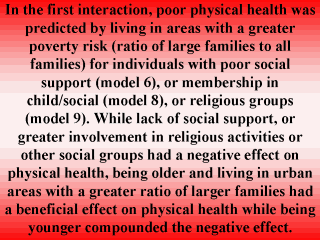 |
In areas with
less poverty risks, age was directly related to poor health. The ratio of family size in
urban areas was related to peripheral geographic location with low access to material
resources, greater income, education and occupational inequality, which increased poor
physical health among younger residents. Although household composition, number of
children, and crowding were not measured directly, given the significant main effect of
relative income inequality, living in areas with poverty risks may have increased stress
levels among those younger with greater expectations for the future. Less life control, or
greater frustration with current life conditions than older residents. |
